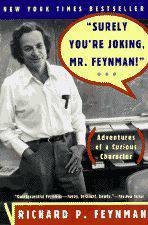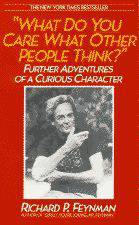

| Click on a book's image or title to order from Amazon.com |

Surely You're Joking, Mr. Feynman!
Norton & Company, TPB, © 1985, 346 pp, ISBN #0-393-31604-1Reviewed July 1997
I'd been meaning to read this collection of essays by Nobel prize-winning physicist Richard Feynman (1918-1988) for some time, and having done so I find that it's every bit as delightful and thoughtful a book as I'd been led to believe. Rather than talking (much) about his work in physics, Feynman instead relates dozens of anecdotes from throughout his life, as a college and graduate student, as a researcher at Los Alamos on the Manhattan Project during World War II, on trips to Brazil and Japan, and as a professor first at Cornell, then at Caltech.
The book won me over early in his stories about his youth and his days at MIT, in which he was always working to learn things - especially how things worked - and how he played relatively harmless practical jokes on his classmates and some waitresses at a local restaurant. Feynman's thirst for clever things to do and clever ways to do ordinary things is remarkable and entertaining (SF author Arthur C. Clarke has demonstrated a similar thirst, demonstrated in his otherwise disappointing novel The Ghost from the Grand Banks).
Far and away the best single essay in the book is "Safecracker Meets Safecracker", detailing how, when at Los Alamos, he decided to make it a personal quest to test the security of every lock he could get his hands on in the place. He describes how standard key-locks are actually quite easy to pick if you know how (which should make every one of us wonder exactly why we bother to have them on the door to our houses; they sound utterly worthless! Of course, Feynman even describes the basic technique for picking them), and then moves on to combination locks, which are considerably harder. Although he never learned to pick the ones on Los Alamos' filing cabinets directly, he did learn that there were many hundreds of times fewer possible combinations than expected, due to the lack of precision in the mechanical devices, and was confident that he could pick any lock in the compound in a maximum of 8 (yes, eight!) hours, if necessary.
Beyond being a collection of entertaining and dubiously-instructive anecdotes, there is something genuine to learn from Feynman. First, he seems to have determined that the ability to project confidence in every situation makes up for many deficiencies one might otherwise have; essentially, that you can bluff your way through a lot in life, especially if you're essentially honest except when absolutely necessary. I think many of us instinctively understand this to be true, but understanding it and doing it are very different things, and Feynman gets away with a lot that few of us would have the nerve to attempt. (The flip side of this, of course, is realizing that you could likewise go far by making a habit of calling someone's bluff on the theory that they're projecting false confidence.)
Despite being a theoretical physicist by trade, Feynman also places a high price on understanding how things really work, and on making the explicit link between the theory and reality. He savagely critiques the educational system of Brazil in the early fifties on these grounds, that the students aren't really understanding what they're being taught, they're just memorizing terms and basic ideas.
In a similar vein, Feynman is often unusually willing to try out something new or unusual, just to see what it's like. Sometimes he doesn't care for it, but other times he quite enjoys it, thereby becoming a drummer and a visual artist of some note in his area. Hence, his perhaps-otherwise-implausibly large number of adventures.
Feynman wraps up the book with a dismissal of people who don't properly explore phenomena they encounter, arguing that scientists have a responsibility to explicitly point out the failings in their theories as much as to tout what's right about them, and he argues that this is exactly what people who believe in paranormal powers and events don't do, for the most part. It's a wonderful summing-up of an outstanding book: That people have a responsibility to themselves and to others to be as thorough as possible, and the rest of the book serves as an instruction that doing so can be fun (and make for some good story-telling afterwards, to boot!). (As an aside, I'd argue that this completeness of exploration is exactly what makes the more recent novels by SF author Vernor Vinge so satisfying.)
Feynman - who dictated the text to a friend of his, who presumably wrote it for him - speaks with a clear, folksy voice, and is entirely personable. He controls his asides carefully and is always directing the reader to something new and even more entertaining than the last thing. It's a terrific exploration of one man's experience as a member of the human race.

"What Do You Care What Other People Think?"
(Further Adventures of a Curious Character)Bantam, TPB, © 1988, 248 pp, ISBN #0-553-34784-5
Reviewed October 1999
A follow-up to his terrific book Surely You're Joking, Mr. Feynman!, What do You Care What Other People Think is a shorter collection of essays, about half of which involve Feynman's contributions to investigating the explosion of the Space Shuttle Challenger in 1986/87. It certainly has the feel of being essays which weren't quite good enough to make the first book, though it's still worth reading.
The first essay, "The Making of a Scientist", is about how he learned to appreciate science from his father and from his experiences at school. It seems a little too obviously an introductory piece, and seems largely superfluous to a reader of the first book. The second piece, the title essay, is more interesting. In the first book, Feynman writes about his experiences at Los Alamos during World War II, with an important aside about the death of his first wife. This essay is about meeting and marrying his wife, and their experiences up until her death, with an important aside about his days about Los Alamos. Similar events, different perspective. The contrast is intriguing.
The center of the book is a collection of photos from Feynman's life. He always looks like he's having fun.
The second half of the book, as I said, involves the Challenger disaster. It's quite long, and is perhaps more detail than is really interesting. Its best point is the process of coming to realize exactly what was faulty in the system, and why the fault - though recognized by some ahead of time - was not corrected. (It all comes down to politics - personal and otherwise - of course.) Feynman sometimes shows contempt for the investigation process as it is directed by the government, and produces to various results only by striking out on his own. He's frustrated by the final report, as it seems to skirt the real issues and doesn't do anything to cause the problems with the process to change.
Overall, this book seems kind of redundant next to the first one. But it does make you want t go thumb through the best part of the first book again, so it can't be all bad.
hits since 13 August 2000.